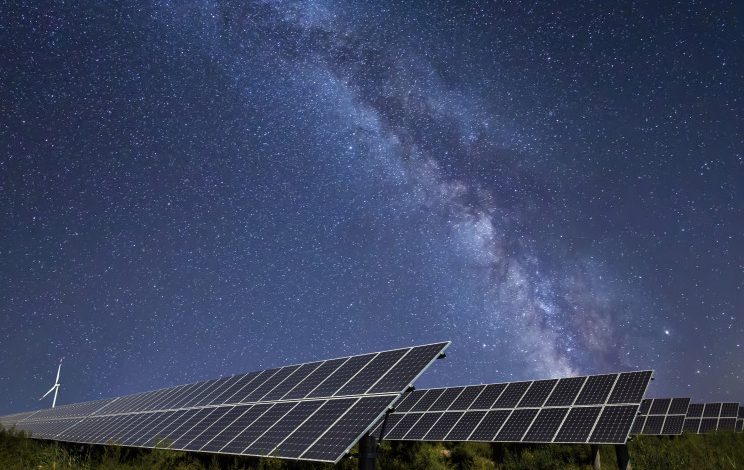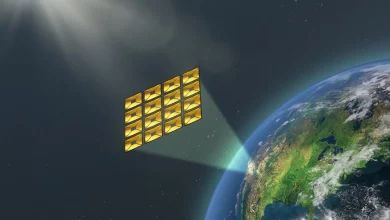
The skies above Stanford, California, were unusually clear for several nights last October.
That was good news for researcher Sid Assawaworrarit and his colleagues. Those conditions were “probably the best of the year,” he tells IE.
Assaworrarit isn’t an astronomer grateful that clouds didn’t block starlight from traveling through the atmosphere and reaching the mirror of his telescope. An electrical engineer, he welcomed the cloudless nights for an entirely different reason: a clear night means infrared light from the surface of solar panels can freely radiate out into space.
That flow of energy enables the device Assaworrarit and his colleagues created — an ordinary solar panel outfitted with a thermoelectric generator — to generate a small amount of electricity from the slight difference in temperature between the ambient air and the surface of a solar panel pointed deep into space.
At night, solar panels turn the table and emit photons
The new technology takes advantage of a surprising fact about solar panels.
“During the day, there’s a light coming in from the Sun and hitting the solar cell, but during the night, something of a reverse happens,” Assawaworrarit says.
That’s because solar panels — like everything warmer than absolute zero — emit infrared radiation.
“There’s actually light going out [from the solar panel], and we use that to generate electricity at night. The photons going out into the night sky actually cool down the solar cell,” he says.
As those photons leave the skyward surface of the solar panel, they cary heat with them. That means that on a clear night — when there are no clouds to reflect infrared light back toward the Earth — the surface of a solar panel will be a few degrees cooler than the air around it. That temperature differential is what Assawaworrarit and his colleagues are taking advantage of. A device called a thermoelectric generator can capture some of the heat flowing from the warmer air to the cooler solar panel and convert it into electricity.
On a clear night, the device Assawaworrarit tested on the Stanford rooftop generates roughly fifty milliwatts for every square meter of solar panel (50 mW/m2).
“I think that’s probably a record number,” he says. But Assawaworrarit and his team aren’t stopping there. He says that with a couple of improvements (and in a good location) such a device could generate twice that amount of electricity.
“The theoretical limit is probably about one or two watts per square meter,” he says. “That’s not a huge number, but there are a lot of applications” where that kind of energy at night would come in handy.
For instance, a large fraction of the world’s population — roughly a billion people — don’t have access to an electrical grid. People living in that situation “can rely on solar during the day, but at night there’s that not much they can do,” he says. Unlike batteries that degrade substantially after a few thousand charge cycles, the kind of thermoelectric generators used in these solar panels are solid state, “so the lifetime is pretty much forever,” he says.
Another good use for the technology is powering the immense network of environmental sensors researchers use to keep tabs on everything from weather conditions to invasive species in far-flung corners of the globe. Again, solar panels that generate a small amount of electricity at night could reduce the need for batteries — and the maintenance and replacement costs they incur.
“If you can get up to a watt per square meter, it would be very attractive from a cost perspective,” Assawaworrarit says.
The invention taps into a source of energy that’s easily overlooked
The Earth is constantly receiving a tremendous amount of energy from the Sun, to the tune of 173,000 terrawatts. Clouds, particles in the atmosphere, and reflective surfaces like snow-covered mountains immediately reflect 30 percent of that energy out into space. The rest of it ends up warming the land, oceans, clouds, atmosphere, and everything else on the planet.
But that energy doesn’t stay here. Except for the additional heat that greenhouse gasses have been trapping once humans started burning copious amounts of fossil fuels since the Industrial Revolution, Earth sends out about as much energy as it receives. That’s why the planet emits a truly mind-blowing amount of energy as infrared radiation.
“It’s a sort of light,” Assawaworrarit says. The infrared radiation that glows from the warm Earth (or anything else) has wavelengths that are too long for eyes to see, but it does carry energy. In fact, more than half of the total amount of solar energy that hits the Earth goes through this process, eventually returning to space.
What Assawaworrarit and his colleagues have done is to devise a new way to capture that energy as it departs the planet. They aren’t the first to use a thermoelectric generator to capture this kind of energy (IE covered one of the first big innovations in this space back in 2019). By integrating this new technology with solar panels that generate electricity during the day, the researchers have taken an important step forward in making it possible for ordinary people to capture this energy for themselves.
It all comes down to radiative cooling
Modern scientists are hardly the first people to notice that a surface pointed toward the cloudless night sky can become colder than the air around it. The phenomenon is called radiative cooling, and you’ve probably seen it yourself first thing in the morning. It’s most apparent in grass after temperatures have fallen into the mid- or low-30s but not quite below freezing.
“Even if the ambient temperature is a few degrees above freezing, the temperature of the [grass] leaf is actually lower,” Assawaworrarit. “If the grass is a few degrees below the ambient temperature, and the ambient is slightly above freezing, then the grass might actually be below freezing point.”
It’s a strange (if subtle) phenomenon that only happens when skies are clear. That’s because clouds warm the ground by reflecting infrared light back onto Earth’s surface. “You won’t be able to see it because it’s happening in a wavelength that humans can’t see,” but radiative cooling happens all the time, Assawaworrarit says.
Modern scientists aren’t the first people to put radiative cooling to work either. Southeastern Iran contains the remains of dozens of ice houses, called Yakhchāls, that Ancient Persians used to exploit the phenomenon. When the structures were in operation, people would pour water into shallow pools next to the ice houses. Even if the air temperature was in the high 30s or low 40s, the water would freeze. In the morning, people would collect the ice and transfer it to a nearby beehive-like structure that used a different set of passive cooling techniques to keep the ice below freezing throughout the summer.
Developing this technology poses several engineering challenges
Understanding the physics behind these nighttime solar panels is only part of the battle. Engineers have been working for years to make them efficient enough to be worthwhile for use in the real world.
Assawaworrarit and his colleagues started working on the problem during the pandemic.
“We got stuck quite a bit in the beginning because the deep the number that we got early on was nowhere near what we expect,” he says. After months of crunching the numbers, the team’s first experiment showed that early iterations of the device produced about one-tenth the amount of electricity they were expecting.
It turned out that one big problem was getting in their way.
“A solar cell is actually not a very good heat conductor,” Assawaworrarit says. “That’s where the problem lies.” The engineers realized that energy escaping the edges of the solar panel wasn’t contributing very much to the system’s energy output because the thermal energy couldn’t easly travel through the solar cell itself.
“Looking back, it sounds straightforward,” he says. “But at that point, it wasn’t obvious.”
The engineers fixed the problem by attaching the solar cell directly to an aluminum plate, which conducts the energy far more efficiently.
“That was sort of an epiphany,” he says.




